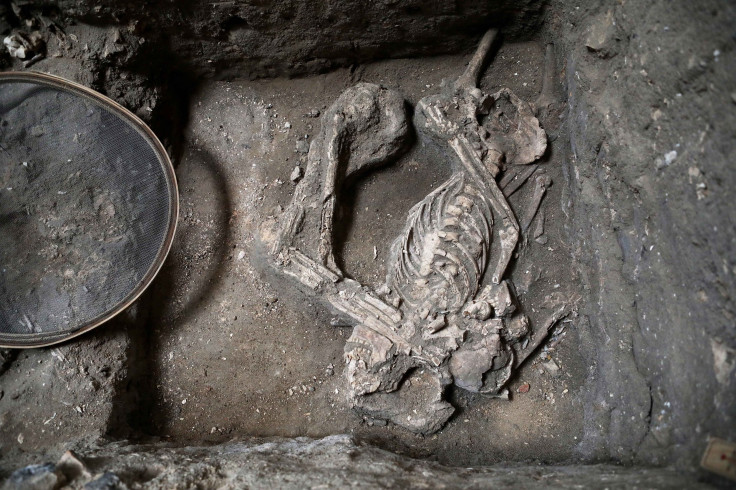Medieval Woman Was Buried While Pregnant, Gave Birth To Baby In Coffin

Italian archaeologists have uncovered a medieval grave containing the remains of a woman buried near Bologna, Italy, with a 38-week-old fetus lying between her legs, reports said Monday.
Researchers believe the fetus "extruded after the burial" and called it an example of a "coffin birth," Forbes reported. The team from the Universities of Ferrara and Bologna said that the child’s leg bones possibly never made it out of the pelvic cavity, however, the upper torso and head likely did, meaning "the fetus was likely partially delivered."
The mother's skeletal remains showed a forehead cut and a 5-millimeter hole adjacent to that, likely intentionally drilled during a primitive skull surgery, according to the researchers.
Coffin birth, which the researchers said was the case in this specific case, is a phenomenon that takes place when a deceased pregnant woman's fetus is expelled within the grave. Around two to five days after the death of the pregnant woman, the phenomenon, also known as “postmortem fetal extrusion,” occurs following build-up of gas pressure inside the body thus forcing the fetus to be ejected from the vaginal canal. Researchers said, in this case, the fetus had already died when the mother was buried.
The case in point was first uncovered back in 2010, when archaeologists found the strange Middle Age burial in Imola, Italy. It suggested a proper, intentional burial, however, they also discovered a pile of bones below the pelvis of the skeletal remains of the woman. The woman's skull had a hole in it making the scene further complicated.

Further investigation was then conducted by the researchers, the results of which have currently been published in the science journal World Neurosurgery.
According to the new research, the buried woman is believed to be somewhere between 25 and 35 years old when she died and was buried. The fetus was at 38 weeks of development (just two weeks less than the time of being full term). The baby’s legs were said to be still inside the mother’s body, however, its head and upper body had dropped below the pelvic cavity. The fetus was already in its head-down orientation (the cephalic position) and was thus positioned for birth, the researchers explained.
Archaeologists Have Discovered a Ghastly 'Coffin Birth' in a Medieval Grave https://t.co/kc1yYF92wy
— ScienceAlert (@ScienceAlert) March 26, 2018
The five-millimeter circular hole across her forehead suggest that she had undergone a procedure called trepanation- an ancient surgical procedure, which involves creating a hole in the skull by either scraping or drilling away layers of bone.
Trepanation was said to be used in the treatment of eclampsia — a hypertensive pregnancy disorder. The researchers proposed that the woman might have undergone skull surgery for this purpose.
"Historically, trepanation was used for treating several symptoms and disorders, such as cranial injuries, high intracranial pressure, convulsions, and high fever — all three of which are also caused by eclampsia," Alba Pasini, a co-author of the study and a researcher from the Department of Biomedical and Specialty Surgical Sciences at University of Ferrara, said in an interview with Gizmodo.
"Scientific literature — both medical and archaeo-anthropological — attests that [these symptoms] were treated through trepanation from prehistory to the contemporary era. We are sure, as reported in the paper, that this treatment did not heal the woman, since there are only the first signs of osteological reaction attesting the beginning of the healing process of the bone, indicating that the woman survived one week from the surgery at most," Pasini added.
The woman, according to the researchers, lived for around one more week following the surgery, and had been buried while still pregnant, and thus that led to her having a coffin birth while her body decomposed, researchers concluded.
© Copyright IBTimes 2024. All rights reserved.












